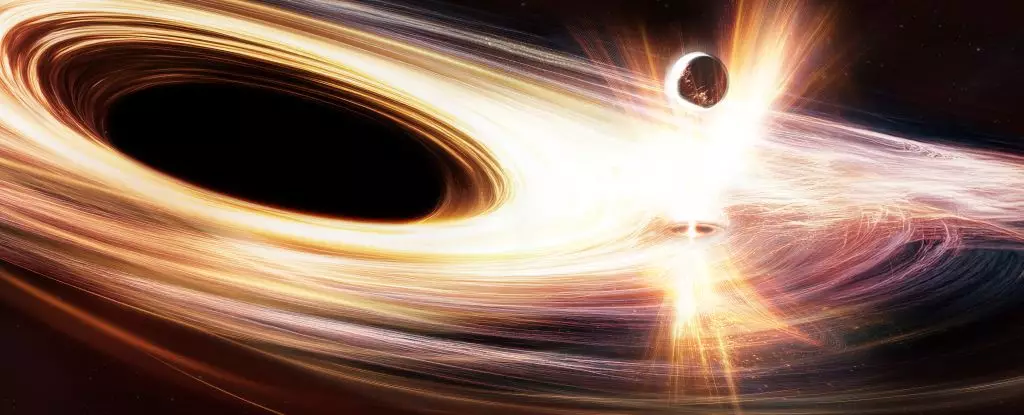Astrophysicists are in a frenzy over the peculiar behavior of a supermassive black hole named Ansky, located a staggering 300 million light-years away in the galaxy SDSS1335+0728. Since 2019, Ansky has captivated scientists with its unexpected resurgence from a dormant state, exhibiting an astonishing array of luminous outbursts. These phenomena, while not entirely alien in the context of black hole behavior, have sparked a whirlwind of curiosity and confusion among researchers, driving them to reassess long-standing theories about these cosmic giants.
The Unprecedented Nature of Ansky’s Eruptions
What sets Ansky apart from other supermassive black holes is the extraordinary intensity and duration of its light emissions. According to astrophysicist Joheen Chakraborty from MIT, Ansky’s X-ray bursts are not just marginally brighter; they are tenfold more luminous and sustained than typical eruptions observed from other quasars. These eruptions release energy a hundred times greater than what scientists have previously recorded, extending over a remarkable 4.5-day cadence. This leaves astrophysicists grappling with the implications for their theoretical models and perceptions of black hole activity.
At its core, Ansky’s behavior defies many conventions established in the study of active galactic nuclei. While black holes are often depicted as relentless cosmic vacuums, their nature is much more nuanced. Supermassive black holes oscillate between active and quiescent states, demonstrating periods of explosive growth interspersed with prolonged phases of relative dormancy. Take, for instance, Sagittarius A*, the black hole at the center of our own Milky Way galaxy, which remains largely inactive. Consequently, scientists are learning that the evolution of black holes plays a decisive role in the formation and growth of the galaxies they inhabit.
Breaking New Ground in Black Hole Studies
Ansky’s case is groundbreaking for multiple reasons. It marks the first real-time observation of a supermassive black hole transitioning into an active state, a significant milestone in understanding black hole dynamics. Lorena Hernández-García, a leading researcher from the Millennium Institute of Astrophysics, articulates the importance of this discovery: “This is the first time we have observed such an event in a black hole that seems to be waking up.” The implications are vast; the emergence of quasi-periodic eruptions like those from Ansky invites a re-evaluation of existing models detailing black hole behavior and the mechanisms that drive their accretion of material.
If quasars are lit by the energy produced when matter falls into black holes, the difficult-to-rationalize nature of Ansky’s eruptions suggests that traditional models may be too simplistic. Unlike classical expectations that attribute these eruptions to minor celestial bodies being consumed by a black hole’s gravitational embrace, Ansky proves that these energetic flares may be the result of a more complex phenomenon. The data hints at a surprising variability that challenges typical perceptions about how black holes operate and the forces governing them.
The Future of Gravitational Wave Astronomy
Compellingly, these unusual phenomena might also open up new avenues in gravitational wave astronomy. Not only do the patterns of Ansky’s outbursts need deeper observation, but they may also be interconnected with gravitational waves—a powerful insight that could be captured by future missions, such as the European Space Agency’s LISA (Laser Interferometer Space Antenna). With the potential to confirm or refute existing theories through empirical observational data, Ansky serves as a beacon guiding the exploration of the universe’s most enigmatic features.
Indeed, the situation surrounding Ansky challenges scientists to reconcile known astrophysics with newfound anomalies. The thrill of discovery comes not just from understanding what Ansky is doing, but why its behavior diverges from expected patterns. Each eruption discloses a story from the depths of space, and with every burst of X-ray light, new questions will undoubtedly emerge, pushing the boundaries of human understanding further.
Implications for Our Understanding of the Universe
The case of Ansky teaches a vital lesson: the cosmos is an ever-evolving tapestry of mysteries waiting to be uncovered. As researchers continue to examine the abyss of black holes, each revelation contributes to the broader narrative of our universe’s evolution and structure. The riveting nature of Ansky’s behavior not only magnifies our fascination with black holes but also underscores the intricate interplay between them and the galaxies they govern. By delving deeper into these cosmic phenomena, humanity draws closer to deciphering the greatest mysteries of the cosmos, reminding us that the universe is richer and more complex than we can ever fully comprehend.


Leave a Reply